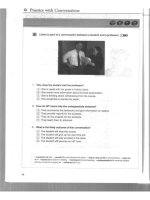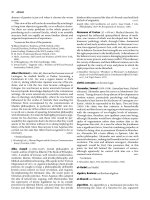How to study enghlish 5 ppsx
Bạn đang xem bản rút gọn của tài liệu. Xem và tải ngay bản đầy đủ của tài liệu tại đây (79.43 KB, 6 trang )
What Keeping Calm Can Do
Lenny freaked out when he saw the chemistry book: “I’m never
going to get through that!” He felt so intimidated by the heavy
book that he didn’t open it until the day before the first quiz.
But putting off studying only makes matters worse. If Lenny had
spent time calming himself down, he could have opened the
book the first time he saw it. He could have put himself in the
mood and taken charge of his studying. He might even have
become interested in chemistry!
HOW TO STUDY
6
The clue is to find what’s comfortable so you get the most out of studying.
You might find that soft classical music works best.
When It’s Quiet
Do you think best in silence? Then you need to block out as much noise
as you can. Get up early, go to bed late, study after the kids have gone to
school. The rest of the time, create quiet: close the door to the living
room, wear earplugs or headphones–or do anything you can to block out
sounds.
Josie, from the box on page 3, might even be able to work something
out with her brother. Maybe he would wear headphones so she could
have quiet to study. Or maybe she could use headphones with music
playing so softly that it wouldn’t disturb her concentration but would
still block out the noises around her.
Try different approaches to see what works for you. There are even
machines you can buy that make white noise to block out distracting
sounds. If you’re thinking of buying one, make sure you hear it first.
What works fine for one person might not work at all for another!
In your notebook, make a list of alternate places to study, keeping in
mind the best types of environments for you. Your local library is a good
place to start!
KEEPING CALM
When you’re calm, you can think clearly and deeply. You’ll find it easier
to make connections and to remember what you’ve been studying.
Try It!
GETTING STARTED
7
P
ICTURE YOURSELF CALM
Think of a place that makes you feel calm. It can be a real place you’ve
been to, some place you’ve seen in a movie or photograph, or a fantasy
place you made up. Close your eyes and get a clear picture of this place
in your head. Try to imagine yourself really there. Sense what you see,
hear, feel, and smell.
For example, if you’re imagining yourself on a beach . . .
• See yourself sitting on the shore.
• Hear the gentle waves lapping the shore and an occasional
seagull calling.
• Feel the warm sand on your toes and the gentle breeze on your
shoulders.
• Smell the salt water.
By using your four senses in this imagination exercise, rather than
just one or two, you heighten the sensation of peace and relaxation,
making a mental image seem like reality.
AS EASY AS BREATHING
Another exercise you can do to become calm is deep breathing. You may
want to first put your mind in your special imaginary place.
• Listen to one of the sounds in your special place, perhaps the
gentle waves lapping the shore. Put your hand over your heart
and listen to your heartbeat.
• With this sound in your head, and sitting comfortably with your
back straight, breathe in, feeling your chest fill with air.
• Breathe out, feeling the emptiness in your chest.
• Repeat breathing in and out several times, inhaling and exhaling,
feeling calmer each time you breathe out.
Use this technique when you feel stressed—because of an
upcoming exam, an enormous chemistry book, or a looming
deadline—and you’ll feel more relaxed and ready to begin.
Try It!
Try It!
I
N SHORT
Keeping calm helps you remain clear-headed. Rewarding yourself, before
and/or after studying helps you get in the mood. Working only for as
long as you can stay alert and pay attention—20 minutes at a time for
most people—helps keep you in the studying mood. Studying in a
favorite place, at a time of day when you’re at your thinking best, helps
you make the most of your study time and efforts.
HOW TO STUDY
8
Practice Tips
Here are some ways you can practice the suggestions of this chapter in
everyday situations. Doing so will make you feel experienced and more
comfortable when you use these same methods to get started studying.
• The next time you find yourself feeling anxious at work or at
home, try imagining a special place and practice deep breathing
to calm yourself.
• The next time you find yourself not wanting to do something that
needs to be done, reward yourself before and/or after doing the
task.
• Before doing something you’ve never done, do something famil-
iar that you can easily accomplish in a short period of time.
• Before doing something new, review what you have done that’s
similar.
9
CHAPTER
2
DISCOVERING
HOW YOU LEARN
You like surprises and your
friend Harry hates them.
You love movies, but Harry
would rather listen to
music. You like different
things because you think
differently. You and Harry
will probably get more out
of studying if you combine
your different styles.
S
uppose you and your friend Harry are
in an American history class, studying the events that led up to
World War I. Films and tapes of speeches about the period are
in the school library. Since you love movies, you might get more out of
watching the films. Since Harry prefers listening, he might get more out
of listening to speeches. If you were to just listen to the speeches and
Harry were to watch the films, neither of you would fully understand
what you’re studying.
HOW TO STUDY
10
PEOPLE THINK AND LEARN DIFFERENTLY
How do you learn? We all have two eyes, two ears, a nose, but we each
look unique. People aren’t the same on the outside, and they’re not the
same inside either. Everyone has their own learning style. You were born
with yours and Harry was born with his; different parts of everybody’s
brain are—well, different!
Think of a person as a seesaw. It’s pretty unusual for someone to
be a perfectly level seesaw, with all learning styles having the same
strength, or weight. For most of us, the seesaw is tilted. Where it goes up,
we have more learning strength, and where it goes down, we have less. We
tilt one way or another but we all stay in the air because one side
compensates for the other. It’s important to know how you learn best, so
you can do more of what works best for you.
You can find clues about how you learn best by looking for a
similarity in the things you like to do. You learn in many different ways,
and you have your own combinations of learning styles.Usually,you’re
comfortable doing certain activities and you get more out of these
activities because they match your learning styles.
The purpose of this chapter is to help you get in touch with the
styles with which you’re most comfortable. Once you’ve identified these
styles, you can move on to the later chapters that focus on a specific style
of learning.
FIVE LEARNING STYLES
There are five different learning styles. Most people have at least one
dominant style, but everyone uses a combination of learning styles,
sometimes depending on the activity they’re doing.
• Eyes. If you like to watch movies and draw or paint, or get
involved in other activities that rely on your eyes, you are proba-
bly a visual learner. Visual learners mainly use their eyes to learn.
• Ears. If you’d rather listen to the radio than read the paper, if you
like listening to music and/or lectures, or participate in other
activities that depend on your ears, you are probably an auditory
learner. Auditory learners mostly use their ears to learn.
DISCOVERING HOW YOU LEARN
11
• Order. If you like to do crossword puzzles, fill out forms, work
math problems, or do other activities in an orderly way, you are
probably a sequential learner. Sequential learners need to put
things in a particular order so they can learn them.
• Images. If you make pictures or designs in your head as you’re
looking at or listening to something, you are learning through
images. People who learn through images are usually global learn-
ers. These people like to see the whole picture and often don’t
need to work through individual parts, as sequential learners do.
• Doing. If you like to keep moving—whether it’s the big-move-
ment action of sports or dancing, or a small-movement action
such as doodling, playing an instrument, or needlework, you
might learn best by motion, and be a kinesthetic learner.
Kinesthetic learners learn best when they keep their bodies or
hands moving.
G
ET IN T
OUCH WITH YOUR
STYLE
Here’s an activity using five general styles to help you get in touch with
how you learn.
• Write in your notebook a list of things you like to do, and things
you’re good at. Include the kinds of jobs you enjoy, clubs you
belong to or to which you’d like to belong, and things you haven’t
done but wish you could.
• Make five columns, one for each general learning style: eyes, ears,
order, images, and doing.
• Now take each item from your list and put it in the appropriate
column. Some things might appear in more than one column.
For instance, playing the clarinet could be both doing (the fingers
are doing the walking) and ears (listening).
• Add the number of items in each column. Which columns have
the most? These are the ones that most likely represent your
strongest learning styles.
Find Out!
1.
2.
3.









